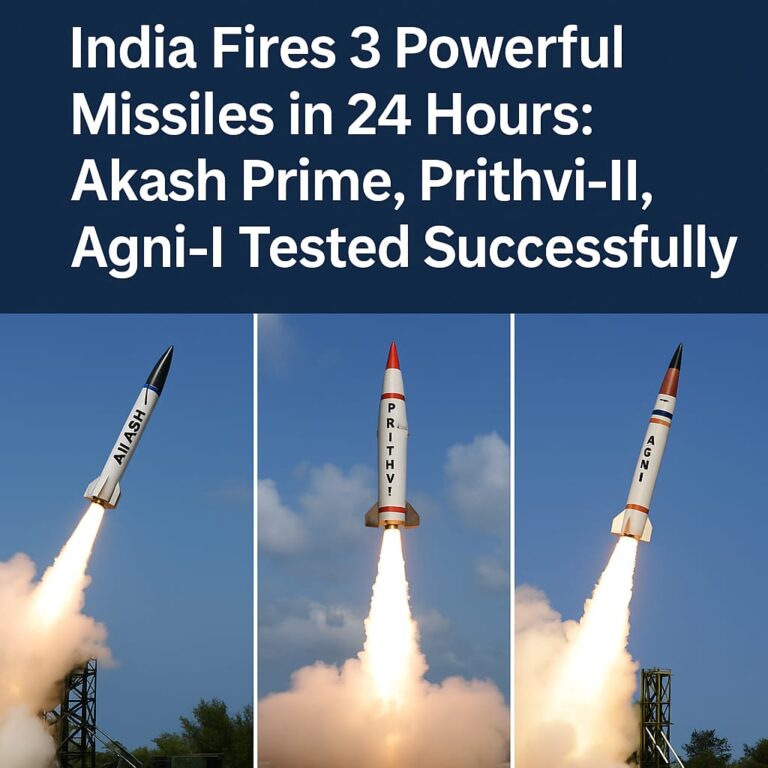“24 Hours, 3 Missile Tests: India’s Big Strategic Firepower Push Explained”

🇮🇳 India assessments 3 foremost Missiles in 24 Hours — A big Strategic Firepower raise
In a bold and rare display of strategic energy, India correctly test-fired 3 major missile structures inside a span of just 24 hours. On July 16 and 17, 2025, the Indian defense status quo conducted stay assessments of the Akash top air defense machine, as well as the Prithvi-II and Agni-I nuclear-succesful ballistic missiles. The speedy succession of tests displays India’s developing army preparedness and technological advancement amid nearby security challenges.
🔰 1. Akash prime: excessive-Altitude Air defense test in Ladakh
On July 16, India’s Defence research and improvement agency (DRDO) and the Indian army at the same time carried out a test of the Akash high surface-to-air missile in Ladakh, at altitudes above 4,500 meters. This missile is an upgraded model of the authentic Akash gadget, now customized for better performance in excessive-altitude and occasional-oxygen environments — particularly relevant for the Himalayan border zones.
The missile correctly intercepted high-speed unmanned aerial targets in hard terrain.
Akash prime consists of stepped forward radar structures, a brand new radio-frequency seeker, and improved reliability.
This test marks a chief bounce in India’s capability to intercept adversarial drones or aircraft within the hard and regularly contested mountainous regions of the northern frontier — especially close to China’s borders.
🛰️ 2. Prithvi-II and Agni-I Ballistic Missile assessments from Odisha
On July 17, two critical ballistic missiles — Prithvi-II and Agni-I — had been effectively examined by India’s Strategic Forces Command from the included take a look at range (ITR), Chandipur, in Odisha.
🌀 Prithvi-II:
brief-variety, liquid-fueled ballistic missile.
range: about 350 km.
able to sporting each conventional and nuclear warheads.
🔥 Agni-I:
Medium-range, stable-fueled ballistic missile.
variety: seven hundred–900 km.
additionally nuclear-capable, with excessive accuracy.
both missiles are part of India’s credible minimal deterrence strategy under its nuclear triad. The check outcomes confirmed that the missiles met all task objectives and performance parameters.
⚙️ three. Strategic and Geopolitical significance
those assessments weren’t just ordinary drills — they send clear strategic indicators.
The Akash prime take a look at complements India’s capability to defend towards aerial threats in rugged terrain, essential in areas like Ladakh, which have seen border tensions with China.
The Prithvi-II and Agni-I tests confirm India’s 2d-strike nuclear readiness, ensuring it remains a effective deterrent inside the vicinity.
especially, professionals consider that such again-to-again trying out reflects India’s heightened military readiness, especially within the face of growing concerns approximately chinese activity within the Himalayas and ongoing pass-border troubles with Pakistan.
🛠️ 4. Indigenous generation & Self-Reliance
one among the biggest takeaways is the demonstration of India’s indigenous defense competencies.
All 3 missile systems — which include their radars, release systems, and guidance — had been in large part developed by way of DRDO, in collaboration with Bharat Dynamics confined and other Indian protection companions.
The a success check of Akash top in high-altitude situations also validates India’s capacity to conform defense systems to actual battlefield requirements.
This aligns with the authorities’s “Aatmanirbhar Bharat” (Self-Reliant India) initiative, which ambitions to reduce dependence on foreign protection imports.
🧭 conclusion
India’s lower back-to-returned missile checks — the Akash top, Prithvi-II, and Agni-I — in only 24 hours mirror a powerful message of strategic preparedness. whether it’s far defensive the skies over Ladakh or ensuring nuclear deterrence, those structures spotlight India’s functionality to reply unexpectedly and efficaciously to threats throughout all domain names.
As worldwide geopolitics grow extra risky, India’s emphasis on modernizing its strategic arsenal, while specializing in self-reliance and nearby stability, is a vital step in safeguarding its countrywide interests.






